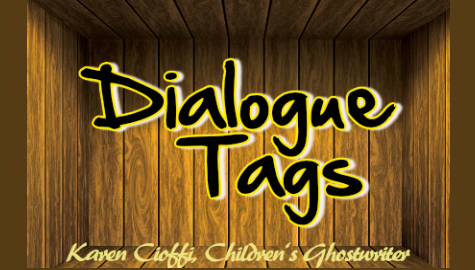I rewrote a young adult book for a client. It was over 100,000 words.
With that many words, the author felt compelled to mix up the dialogue tags.
That, though, is never a good idea.
Some of the tags he used included spat, laughed, teased, smirked, joked, yawned, and sneered.
But my client isn’t the only one who doesn’t realize that there are specific words for dialogue tags. That might be because new authors aren’t familiar with the tag’s purpose.
So, what exactly is a dialogue tag?
According to The Write Practice, “they ‘tag’ the dialogue to a particular character. Also often referred to as an attribution, a dialogue tag is a small phrase either before, after, or in between the actual dialogue itself.”
That puts it pretty simple.
Dialogue tags are phrases that identify who is speaking. They are a must for clarity and in order to keep the reader in the know and involved in the story.
A few examples:
“What was that?” asked John.
“I couldn’t finish my homework,” John said.
“If I go to the store,” John said, “I’ll pick up milk.”
So, you can see that dialogue tags are straight forward. They allow the reader to know who’s talking.
The basic tags are said, replied, asked, and answered. These tags become invisible to the reader. The reader can acknowledge who is talking while not thinking twice about the tag.
But when the basics just aren’t enough, you can also use whispered, shouted, mumbled, and muttered. They should be used sparingly and take note that mumbled and muttered have two different meanings.
So, going back to dialogue tags that shouldn’t be used, I did a search and was surprised at the results.
One site had a list of dialogue tags that included, emitted, bubbled, chuckled, grinned, sang, smiled, and rejoiced.
Another site had grieved, mewled, bawled, blubbered, fretted, agonized, comforted, admired, hissed, soothed, glowered, placated, assented, tittered, and sobbed, stating they could be used as dialogue tags.
This may be one of the reasons why some writers feel it’s okay to use these words and any others they can think of.
A good way to think about whether a word can be used as a tag is to think of the word and what it means.
You can’t blubber dialogue.
You can’t admire dialogue.
You can’t comfort dialogue.
You can’t sneer dialogue.
You can’t tease dialogue.
You can’t emit dialogue.
You can’t spit dialogue. Although you can spit as you talk.
Dialogue tags and adverbs.
This is another common problem that can arise with dialogue and tags – the use of adverbs.
My client also did a lot of this as well.
Using an adverb after a tag looks like this:
“Don’t bother getting up,” John said angrily.
“You’re beautiful,” John said admiringly.
“Get out of my chair,” John said, disgruntled.
Instead of using adverbs, the sentence or paragraph should show how the character is feeling.
Here’s an example:
Ellen couldn’t open her eyes. Crying all night left them swollen and achy. “How could this happen?”
Showing what’s going on allows the reader to know how she’s feeling. You wouldn’t need to add “sadly” at the end of the tag.
Do you always have to use dialogue tags?
Another question that can come up about dialogue tags is whether they have to be used all the time.
The answer is no, as long as it’s clear who’s speaking.
John shook his head. “No way. I’m not going.”
“You’ve got to,” said Pete.
“No, I don’t.”
In this simple example, you can see that only one of the dialogues has a tag.
The first one notes who’s talking by using: John shook his head.
The next dialogue is from Pete and is tagged.
The third dialogue line is John responding to Pete. As there are only two characters in the scene, the reader will know who is speaking.
Writing dialogue is easy once you get the hang of it.
A good way to learn how to write dialogue with proper tags is to read a lot of traditionally published books. Pay attention to the dialogue and tags.
It’s not that I’m putting down self-published books, I’ve self-published two books. The problem is not all self-published books are done professionally.
Traditionally published books have professionals editing them; they have gatekeepers to ensure the story is quality. They know the ropes and it’s important to learn from books that are done right.

I’m a working children’s ghostwriter, rewriter, editor, and coach. I can help turn your story into a book you’ll be proud to be the author of, one that’s publishable and marketable.
OTHER HELP I OFFER:
HOW TO WRITE A CHILDREN’S FICTION BOOK
A DIY book to help you write your own children’s book.
FICTION WRITING FOR CHILDREN eCOURSE
4-Weeks / 8 Sections Instructor Guided Self-Study Mentoring Program
WRITERS ON THE MOVE SELF-PUBLISHING SERVICE
Self-publishing help for children’s authors
(Picture books and chapter books)
You can contact me at: kcioffiventrice@gmail.com.

Why Do You Want to Write a Children’s Book?
When Is It Time to Let Your Manuscript Fly?
The Hardest Part of Writing is Actually Starting


2 thoughts on “Dialogue and Tags”